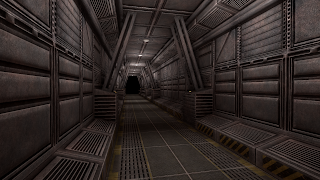Currently I am working on the second phase of the MapData generator, which is to scan the map for scene objects and then adjust the walkable/unwalkable data accordingly. The basics are working fine from a simple AABB check per collision type. Although I am only using the x and z returns at the moment, a more "honest" check would also require y0 and y1 with reference to terrain elevation to be taken into account, but for now this will do as I have another system in mind to further "refine" the AABB space check.
I also integrated a version of my Blitzmax A* system, and have a test "AI Bot" that can path the generated data in the editor and traverse the loaded map. Debugging is currently paramount, especially with regard to the data generated and co-ordinate conversion between the different ways arrays and tables within Blitzmax and lua store data and the co-ordinate system of an .sbx file. On smaller maps I simply drew a small coloured cube at the grid position, and made use of LE's view range to "cull out" an area surrounding the cameras position. A physical pick test which did not rely on any generated data would then tell me if the system was aligned correctly. At the moment I am confident that the formulas I have derived are working fine.
The issue with this type of debugging is it is only practical on small maps, whilst alignment will (should) remain the same regardless of map size, drawing check cubes for every grid tile is a non starter once the map goes over a certain size, as it eats up the available memory to a point when the application will simply crash whilst generating or indeed with very large maps simply crash on start. The map in the videos is "128 x 128" or more precisely 129 x 129 with an MpT of 2 this equates to 66,049 "tiles" which would require 66,049 check cubes to be created. Whereas a "1024 x 1024" with an MpT of 2 equates to 4,198,401 "tiles" which would require 4,198,401 check cubes to be created and a "4096 x 4096" with an MpT of 2 equates to 67,125,249 "tiles" which would require 67,125,249 check cubes to be created. So my solution was to write a function for both the camera and the AI Bot that would create, on the fly, a set sized area of check cubes around the respective focal points.
So, whilst "playing" around with different ways to save and retrieve the data generated for a map, I tried the Portable Network Graphics (.png) image format, mainly to see a pictorial representation of the walkable and unwalkable areas of a map, but also as another way of storing the data, where the red and green channels act as the 1's and 0's stored in the .dat .txt and .lua files. It then dawned on me that an extra "cost" per walkable tile could be embedded in the green channels value, such as the slope of the tile, the flatter the tile, the easier the route. Writing a small routine to determine the slope of a walkable tile (along the same lines used to determine walkable/unwalkable) the value written to the green channel was adjusted a set amount for a particular slope range. The result can be seen below.
This set me thinking, why just store slope data and walkable and unwalkable logic. Of course, you can change the value of the map data stored as values in .dat .txt and .lua files, for instance, instead of 1 meaning unwalkable, the value 0 could be used with walkable tiles having a value ( 1,2,3,4....) which reflects extra cost. But using the .png format this can be done using only two channels of the single (co-ordinate) pixels returned ARGB value.
But channels A and B are left unused, both of which can contain a value 0-255 (00-ff). So why not use them to reference area specific AI behaviour. One scenario might be, a town crier NPC, areas where that NPC is required to "do his stuff" could be defined by a certain value stored in either the A or B channels of the single (co-ordinate) pixels returned ARGB value, this value would only be recognised by that particular NPC class, so other NPC types would simply ignore it. The AI behaviour routines would be encapsulated into the lua control scripts for that class, simply waiting to be triggered. Of course it maybe required that an "area" should have several AI behavioural aspects associated with it, currently I can think of a way to attach three behavioural aspects to a single grid tile using the colour information from a single pixel, but I have a few other ideas on a way to increase that. Those ideas will have to wait as I am trying not to do what I always do and get side-tracked, but they are on the to do list.
This approach would also fit in well with my ideas about Ambient NPC Populations, where the vast majority of control resides in the hands of the "map".
This is all still very much a WIP, but shows potential.








































